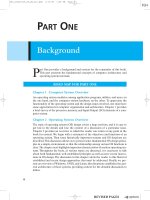Operating system internal and design principles by williams stallings chapter 010
Bạn đang xem bản rút gọn của tài liệu. Xem và tải ngay bản đầy đủ của tài liệu tại đây (301.45 KB, 57 trang )
Multiprocessor and Real-Time
Scheduling
Chapter 10
1
Classifications of
Multiprocessor Systems
• Loosely coupled or distributed multiprocessor,
or cluster
– Each processor has its own memory and I/O
channels
• Functionally specialized processors
– Such as I/O processor
– Controlled by a master processor
• Tightly coupled multiprocessing
– Processors share main memory
– Controlled by operating system
2
Independent Parallelism
• Separate application or job
• No synchronization among processes
• Example is time-sharing system
3
Coarse and Very CoarseGrained Parallelism
• Synchronization among processes at a very gross level
• Good for concurrent processes running on a
multiprogrammed uniprocessor
– Can by supported on a multiprocessor with
little change
4
Medium-Grained Parallelism
• Single application is a collection of threads
• Threads usually interact frequently
5
Fine-Grained Parallelism
• Highly parallel applications
• Specialized and fragmented area
6
Scheduling
• Assignment of processes to processors
• Use of multiprogramming on individual processors
• Actual dispatching of a process
7
Assignment of Processes to
Processors
• Treat processors as a pooled resource and
assign process to processors on demand
• Permanently assign process to a processor
–
–
–
–
Known as group or gang scheduling
Dedicate short-term queue for each processor
Less overhead
Processor could be idle while another processor
has a backlog
8
Assignment of Processes to
Processors
• Global queue
– Schedule to any available processor
• Master/slave architecture
– Key kernel functions always run on a particular
processor
– Master is responsible for scheduling
– Slave sends service request to the master
– Disadvantages
• Failure of master brings down whole system
• Master can become a performance bottleneck
9
Assignment of Processes to
Processors
• Peer architecture
– Operating system can execute on any
processor
– Each processor does self-scheduling
– Complicates the operating system
• Make sure two processors do not choose the
same process
10
11
Process Scheduling
• Single queue for all processes
• Multiple queues are used for priorities
• All queues feed to the common pool of processors
12
Thread Scheduling
• Executes separate from the rest of the process
• An application can be a set of threads that cooperate
and execute concurrently in the same address space
• Threads running on separate processors yields a
dramatic gain in performance
13
Multiprocessor Thread
Scheduling
• Load sharing
– Processes are not assigned to a particular
processor
• Gang scheduling
– A set of related threads is scheduled to run
on a set of processors at the same time
14
Multiprocessor Thread
Scheduling
• Dedicated processor assignment
– Threads are assigned to a specific processor
• Dynamic scheduling
– Number of threads can be altered during
course of execution
15
Load Sharing
• Load is distributed evenly across the processors
• No centralized scheduler required
• Use global queues
16
Disadvantages of Load
Sharing
• Central queue needs mutual exclusion
– May be a bottleneck when more than one
processor looks for work at the same time
• Preemptive threads are unlikely resume execution on
the same processor
– Cache use is less efficient
• If all threads are in the global queue, all threads of a
program will not gain access to the processors at the
same time
17
Gang Scheduling
• Simultaneous scheduling of threads that make up a
single process
• Useful for applications where performance severely
degrades when any part of the application is not
running
• Threads often need to synchronize with each other
18
Scheduling Groups
19
Dedicated Processor
Assignment
• When application is scheduled, its threads are
assigned to a processor
• Some processors may be idle
• No multiprogramming of processors
20
21
Dynamic Scheduling
• Number of threads in a process are altered
dynamically by the application
• Operating system adjust the load to improve
utilization
– Assign idle processors
– New arrivals may be assigned to a processor that is
used by a job currently using more than one
processor
– Hold request until processor is available
– Assign processor a jog in the list that currently has
no processors (i.e., to all waiting new arrivals)
22
Real-Time Systems
• Correctness of the system depends not only on the
logical result of the computation but also on the time
at which the results are produced
• Tasks or processes attempt to control or react to events
that take place in the outside world
• These events occur in “real time” and tasks must be
able to keep up with them
23
Real-Time Systems
• Control of laboratory experiments
• Process control in industrial plants
• Robotics
• Air traffic control
• Telecommunications
• Military command and control systems
24
Characteristics of Real-Time
Operating Systems
• Deterministic
– Operations are performed at fixed,
predetermined times or within
predetermined time intervals
– Concerned with how long the operating
system delays before acknowledging an
interrupt and there is sufficient capacity to
handle all the requests within the required
time
25









